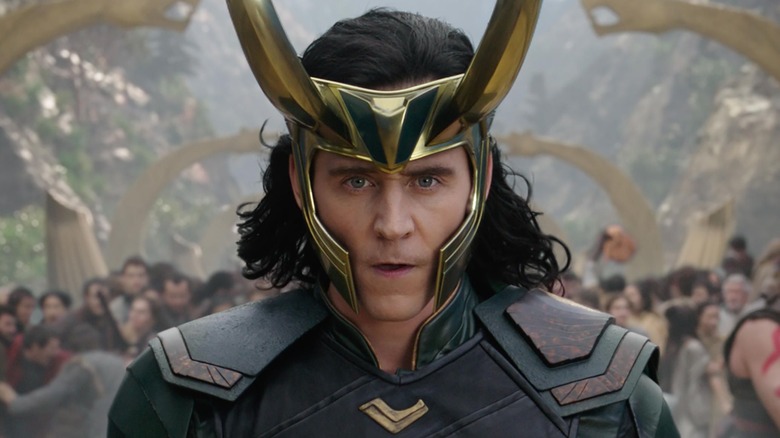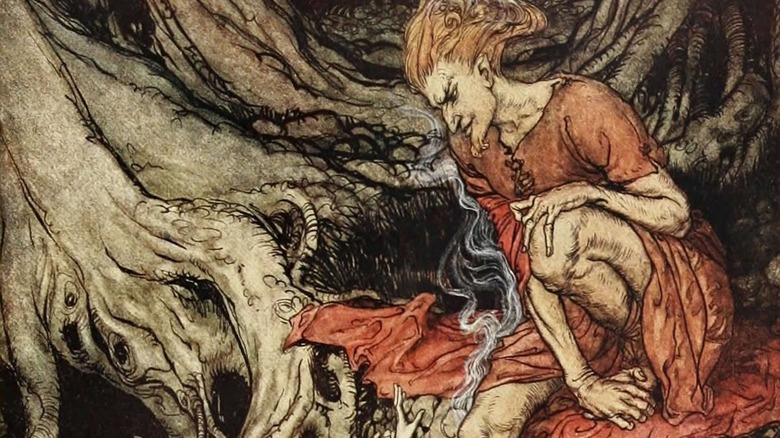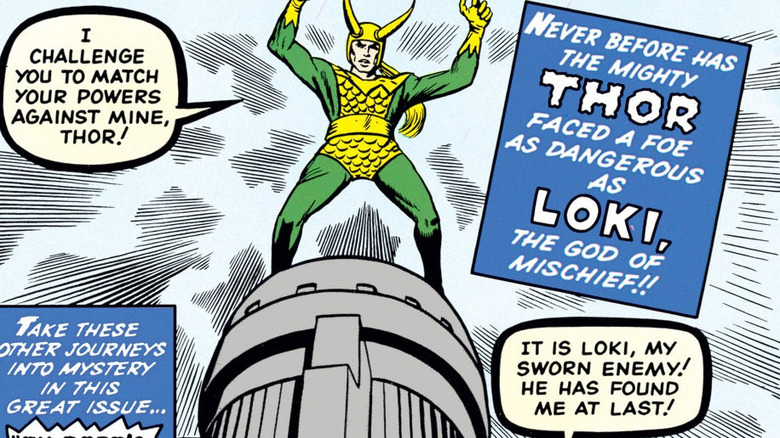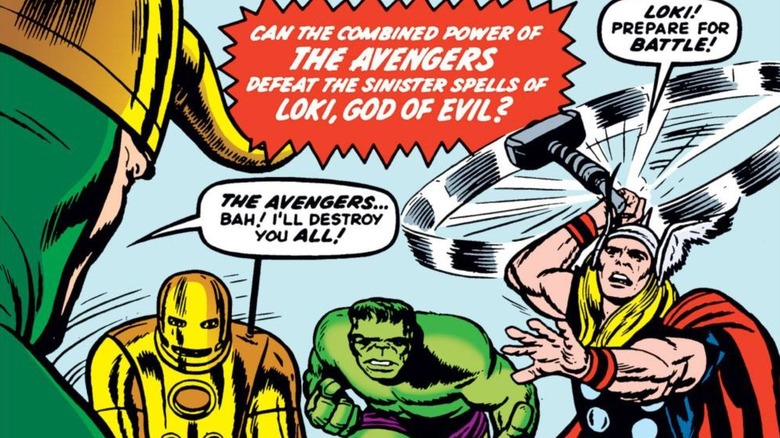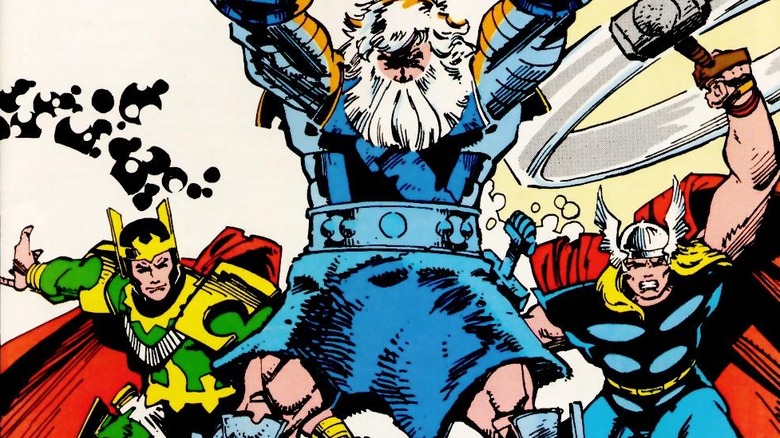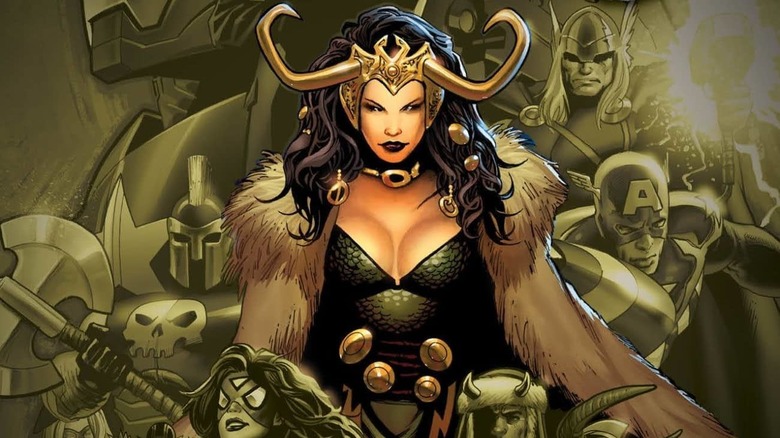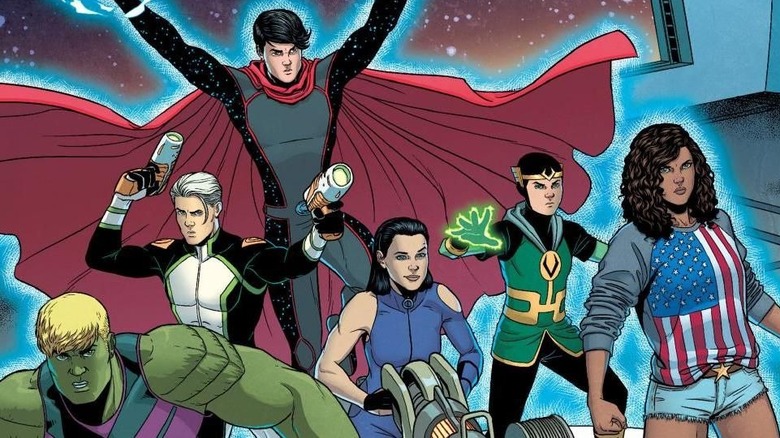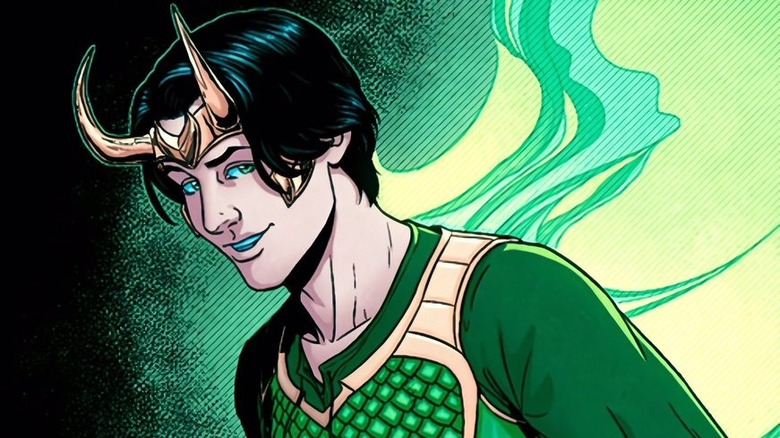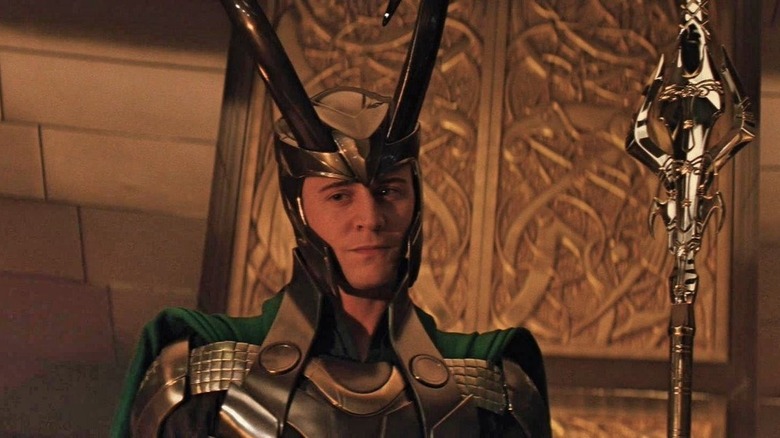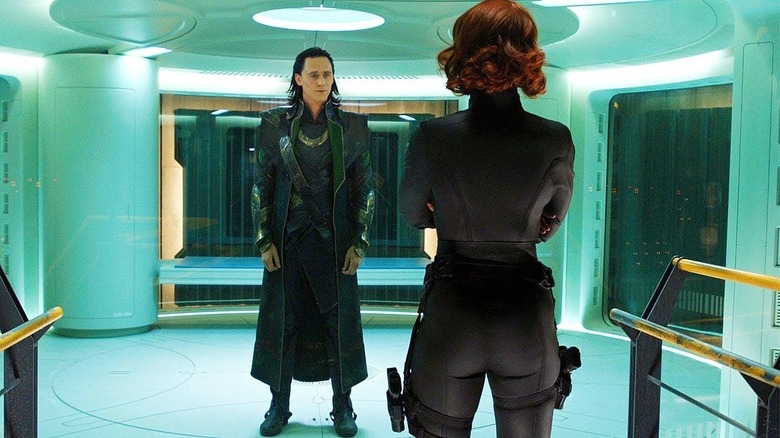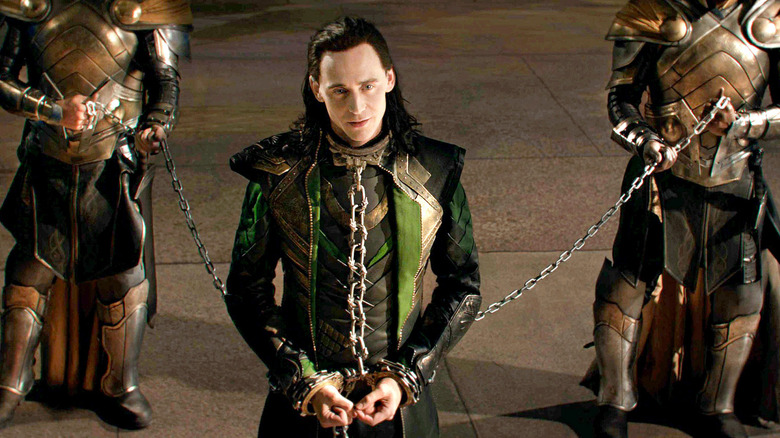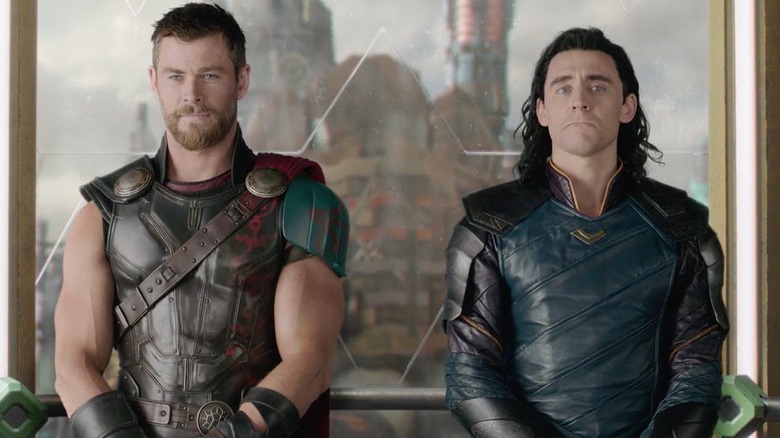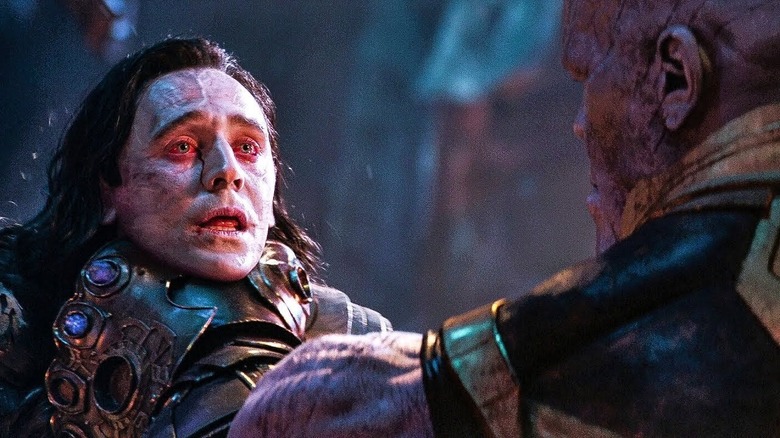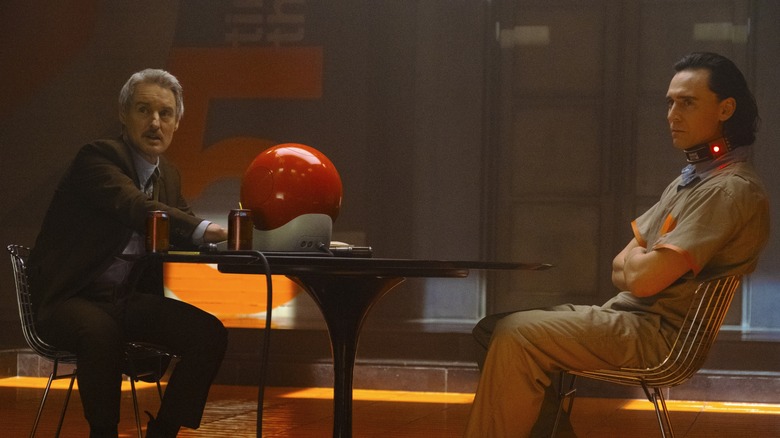The Untold Truth Of Marvel's Loki
There's no denying that Loki, god of mischief, is one of the most popular characters in the MCU, which is of course how he got his own TV series on Disney+. He wasn't always a star, however. Long before he was the handsome antihero in multiple blockbuster movies, he was a cackling supervillain in a whole bunch of old comics. And before that, of course, he was an actual god in mythology. Along the way, he's also been a woman, a child, and a secret agent. Don't worry, we'll get to all that in due time.
Loki is a far more complicated figure than most in superhero movies, which is no doubt part of his charm. So let's dive in deep, starting all the way back at his ancient beginnings, and explore the untold truth of Loki: who is, who he was, and who he might yet become in the future.
A trickster god in ancient times
Like Thor and Odin, Loki originated in Norse mythology, where they were all major pre-Christian deities of the Scandinavian people. Where as most Norse gods were big burly guys with long beards, Loki was always portrayed as lithe, androgynous, and sneaky. Although he was the child of Frost Giants, he was associated with fire and the color red. Like fire, he could not be easily contained and never kept to just one shape. He and Odin, king of the gods, were blood brothers, which made him basically a member of the family no matter how much trouble he caused. And as the god of mischief, he caused no end of trouble.
He also produced monstrous children, who had their own roles to play in the mythology. He was the father of Hel, the half-withered goddess of the underworld, and of Fenrir, the giant Wolf who bit the hand off of the god Tyr. Having once taken the form of a mare, he was the mother of Odin's eight-legged horse, Sleipnir.
As a prank, Loki once cut all of the hair off of Thor's wife Sif. When he got in trouble for it, he made amends by giving Sif new hair spun of gold, and also commissioning the dwarves to forge Thor's famous hammer, Mjolnir. When Loki proved too troublesome, Odin bound him under the Earth, where a serpent constantly drips poison on his face. He'll be released with the coming of Ragnarok, the Norse apocalypse, in which all the gods and monsters will fight to the death.
A supervillain in the '60s
Loki's first appearance in Marvel Comics was in Journey into Mystery #85, published in 1962. This version was created by Jack Kirby and Stan Lee, who had introduced Thor only two issues earlier. Once Thor had become a superhero, it only made sense to bring in Loki as a supervillain. Stan Lee freely drew what he wanted from the Norse myths, while Kirby created a visual language for Marvel's Asgard — one that made these super-gods look unlike any Norse people who'd ever lived, while retaining some basic iconography.
The new Loki was still slimmer than Thor and Odin, but now he had black hair and dressed in green and gold. Whereas Thor's helmet had wings, Loki's had large horns. Norse helmets never had either, but it was a common misconception that they did, and obvious Loki's devilish horns contrasted perfectly with Thor's angelic wings. Instead of Odin's blood brother, Marvel Loki was his adopted son, making him Thor's brother, and thus a more equal adversary. He relied less on shapeshifting than his mythical counterpart, but made up for it with impressive skills at sorcery.
The very first Avengers villain
Loki became Thor's recurring arch enemy, and perhaps even more importantly, he was the very first villain who faced the Avengers. In fact, he accidentally brought the team together. Attempting to mess with Thor from a distance while imprisoned in Asgard in Avengers #1 (also by Lee and Kirby, of course), Loki manipulated the Hulk to make people think we was on a rampage. That got not only Thor involved, but also Iron Man, Ant-Man, and the Wasp. When the four heroes realized Loki was the true culprit, they teamed up with the maligned Hulk to battle Loki. Afterwards, they decided to stay together as a team, using their combined powers to protect the world from threats too big for just one hero. It wasn't long before a thawed-out Captain America joined the team, followed by Hawkeye, Scarlet Witch, and on and on to the present day.
In later comics, like Avengers #300, Loki would lament having brought about this team that would be such a thorn in his side over the years. It wouldn't even be the last Avengers team Loki would put together, but the next time he'd do it on purpose.
An anti-hero for the '80s
Supervillain or not, Loki was still Thor's brother. That made their relationship much more complex than other heroes and their archenemies. Doctor Doom purely hates Mister Fantastic with all his heart, for example, and Doctor Octopus feels the same way about Spider-Man. But with Loki, there's some part of him that loves Thor, and knows Thor loves him back, just as they both love their father Odin. On top of that, as more of a mischievous sorcerer than an evil world-conqueror, Loki was just too interesting to stay entirely a villain forever. So, in time, there were stories where he teamed up with Thor to face greater threats.
The most notable example was in the 1980s, during the beloved and acclaimed Thor run by writer/artist Walt Simonson. In the culmination of a long-foreshadowed plot, the fire giant Surtur (also a loosely adapted figure from Norse myth) was attacking Asgard with an army of the dead, and threatening all the realms beyond. In a moment fans will never forget, Odin and his two sons stormed into battle together, each with a battle cry and that revealed their priorities in resisting Surtur. Odin says, "For Asgard!" Thor says, "For Midgard!" And Loki says, "For myself!"
A lady when you least expect it
In the 21st Century, as comics got somewhat more broadminded, Loki began to take on the previously ignored gender-blurring aspects of his mythological counterpart. When Loki first appeared in female form, it turned out that the god of mischief was possessing the body of the goddess Sif. In later comics, however, Loki would go on to display an ability (and sometimes, a tendency) to change gender without changing bodies, shifting from male to female on a whim or as particular stories demanded it.
For example, during the "Original Sins" crossover, Odin, Thor, and Loki traveled to a realm ruled by warlike female angels. Seeing how distrustful they were of men, Loki took on a female form to better ingratiate herself to them. In other stories, Loki would shift genders with far less reason, and later writers made it clear that gender fluidity is a fundamental part of who Loki is, even if it took decades for that to be reflected in comics.
Reincarnated and making friends
During the "Siege" crossover, Loki sacrificed himself and died. He was then reincarnated as an adolescent boy. Far more pure of heart than his older counterpart, Kid Loki (as he came to be known) had his own series of adventures in a new volume of "Journey Into Mystery" written by Kieron Gillen with art by Doug Braithwhaite. At the end of that story, Kid Loki's body was taken over by a more amoral version of the character from his previous incarnation — although he retained the Kid Loki identity. By this point in comics, Loki was becoming a far more fluid character, in keeping with his mythological predecessor. He seemed to freely shift not only with regard to gender, but also age, personality, moral alignment, and so forth.
Kid Loki went on to found a new version of the Young Avengers, featuring the Kate Bishop version of Hawkeye, as well as Wiccan, Hulkling, Marvel Boy, and America Chavez. Over the course of that series, written by Gillen and drawn by Jamie McKelvie, the other young heroes gradually came to trust this young god of mischief, even as Loki himself struggled with whether or not he was worthy of that trust.
At last: Heartthrob Loki
Late in "Young Avengers," Kid Loki is magically aged up to around college age. He remained younger than he'd previously been, while becoming enough of an adult to interact with Thor and other adult characters without being treated like a child. This was also the first time, not to put too fine a point on it, that Loki was sexy (not counting when he was inhabiting Sif's body). By this time, Tom Hiddleston was playing the character in movies (more on him momentarily), and the internet was full of people with crushes on the Norse god of mischief. So it made sense to make Loki more of a heartthrob in the comics as well.
After the end of "Young Avengers," Loki got his own comic, titled "Loki: Agent of Asgard," written by Al Ewing and drawn by Lee Garbett. The idea behind the title was that Loki, no longer villainous but still amoral, was perfectly suited to take on secret and sometimes ethically suspect missions for the rulers of Asgard, like a one-god black ops team. It was a perfect premise for the character, and led to some well-loved stories.
The Tom Hiddleston factor
Meanwhile, the Marvel Cinematic Universe was making Loki more popular than he'd ever been, with tons of people who'd never read a Marvel comic becoming big fans of the character. A huge part of that popularity has to be attributed to the work of Tom Hiddleston, the handsome English actor who was cast in the role. Most of Hiddleston's previous acting work was on British television, and he was largely unknown in the United States. That changed with the release of "Thor" in 2011, in which Hiddleston's Loki was the primary antagonist.
At the beginning of the movie, Loki is presented as an ally to his brother Thor (Chris Hemsworth), accompanying the thunder god and his friends on an ill-fated trip to Jotunheim, home of the Frost Giants. Things soon break down, however, when Thor is exiled to Earth and Loki learns he's actually of the Frost Giant race himself. As Odin (Anthony Hopkins) enters a mystical slumber, Loki plots to take over Asgard himself. To do that he has to remove Thor from the line of succession, even if it means killing him.
Hemsworth is set up as the impossibly handsome object of desire in the film (far more than male heroes in movies usually are), but many viewers found Hiddleston the more charming of the two, and the Loki fandom quickly sprang up online. Although he was the villain of the piece, fans enjoyed his complicated morality as much as his handsome face.
The very first Avengers villain, again
Just as Loki was responsible for the founding of the original Avengers in the comics, so too was Hiddleston's version in 2012's" The Avengers." In this version, Loki is wielding a mind-controlling staff — later revealed to be powered by one of the Infinity Stones — and is working in tandem with an alien race (secretly led by Thanos, although not even Loki knows that) in an attempt to conquer the Earth. To stop him, SHIELD brings together Thor, Iron Man (Robert Downey Jr.), Captain America (Chris Evans), the Hulk (Mark Ruffalo), Black Widow (Scarlett Johansen), and Hawkeye (Jeremy Renner). Once again, Loki's actions lead to the formation of Earth's greatest super-team, to his regret.
Loki is perhaps a bit less likable in this movie, coming off as a bit more fascistic and also having to deliver Joss Whedon dialogue — which includes some weird archaic misogyny directed at Black Widow. Loki even murders fan favorite SHIELD agent Phil Coulson (Clark Gregg), although he'd come back to life for TV's "Agents of SHIELD." Still, Hiddleston remains intensely charming, and the Loki fandom was thus undeterred.
An ally for a 'Dark World'
2013's "Thor: The Dark World" finds Loki imprisoned in Asgard following the events of "The Avengers." When Dark Elves invade and kill Frigga, mother of Thor and adoptive mother of Loki, Thor releases Loki to help defeat the Elves. While this sequel doesn't stand up to the rest of the franchise and is frequently criticized, audiences did get something they'd been wanting: a less evil Loki. In fact, that's what Tom Hiddleston wanted as well. In a 2013 interview with Jane Crowther for Total Film magazine, Hiddleston explained, "When I met Alan [Taylor, director of 'Dark World'], he asked me how I thought I could do Loki again without repeating myself and I remembered talking with Kevin Feige when we were on the 'Avengers' promotional tour. I said, 'OK, you've seen Thor and Loki be antagonistic for two films now. It would be amazing to see them fight side by side. I've been the bad guy now twice, so I can't be again, or otherwise I shouldn't be in the film. So we have to find a new role for me to play.'"
Loki's duplicity inevitably emerges at the film's end, however. The god of mischief appears to die heroically in battle with the Dark Elves, but he later reveals himself (to only the viewers) as alive and masquerading as Odin. By taking his father's form, Loki has achieved his ambition to rule Asgard.
A friend for 'Ragnarok'
After appearing in Marvel movies for three years in a row, Loki had a four-year break before turning back up in 2017's "Thor: Ragnarok." Upon returning to Asgard, Thor finds his brother still impersonating Odin. The two go in search of the real Odin, who has returned to Norway, the land where he once was worshiped, to die. Upon his death, the Death Goddess Hela (Cate Blanchett) is freed from an ancient imprisonment. She effortlessly destroys Thor's hammer and then sends him and Loki careening into endless space.
Loki finds himself on the planet Sakaar and ingratiates himself to its ruler, the hedonistic Grandmaster (Jeff Goldblum). Thor soon arrives as well and is forced to fight as a slave in the gladiatorial arena, where his first opponent is the Hulk. Soon Thor and Loki team up with Bruce Banner and a long-lost Asgardian Valkyrie (Tessa Thompson) to escape Sakaar and return to Asgard to face Hela.
Director Taika Waititi brings a new level of humor and weirdness to this movie, which is a perfect environment for Loki to shine. He's still not exactly trustworthy, but he's not a villain at all anymore, and ultimately proves himself a worthy ally to his brother as the two escape the destruction of Asgard with most of the population in a huge ship. This new status quo, however, would be sadly short-lived.
The villain who died a hero
Avengers: Infinity War, released in 2018, is the climax of the Marvel meta-story that had been building since the first movie. It's fitting, therefore, that it begins with Thanos invading the Asgardian ship and killing Loki. The original Avengers villain dies a hero, at the hands of the ultimate villain who was secretly using Loki during that invasion of Earth that seems so long ago now. At this point, Thanos is gathering the Infinity Stones as part of his mission to wipe out half of all life in the universe, and none of the Asgardians is powerful enough to stop him from gaining the Tesseract, the Infinity Stone that was at the center of that plot in Avengers.
Hiddleston's Loki had evolved so far by this point that it was sad for basically everyone, not just the Loki mega-fans, to see him strangled to death by Thanos. He came so close to being a hero in his own right, and maybe, there at the end, he was one. When he turned up next, however, it was as the villain he'd once been.
A Loki from another world
Thanos wins at the end of "Infinity War," so in 2019's "Avengers: Endgame," the surviving Avengers have to go back in time to recover the Infinity Stones from various points in history — before they were acquired by Thanos. As they explain before doing so, each time they change the past, their actions create an alternate timeline where things went differently. One such trip is to the aftermath of the invasion in the first "Avengers," when Loki had been defeated and taken into custody, with the goal of attaining the Tesseract. Realizing that things have gotten weird, Loki is able to get his hands on the Tesseract once more, and use it to escape to parts unknown.
What this means, of course, is that there's a Loki out there in the Marvel multiverse again, despite his death at Thanos' hands in the main timeline. But what it also means is that the Loki who now exists is one who'd never fought alongside Thor against the Dark Elves or helped save the other Asgardians from Hela. This Loki comes directly from a time when he was very much a villain.
Loki gets his own show
The alternate timeline Loki from Infinity War got his own series on Disney+. At the beginning of the series, he's a prisoner of the Time Variance Authority, an organization from Marvel Comics that keeps the timelines organized and time flowing smoothly. The official synopsis (via CBR) states that after his apprehension, Loki is "given a choice: face deletion from reality or assist in catching an even greater threat." The trailers show a lot of scenes with Loki interacting with TVA agent Mobius M. Mobius (Owen Wilson).
We don't know where Loki will end up at the end of his series, either physically or morally. Nevertheless, we can probably count on him being positioned to appear in future MCU projects. After all, they went to the effort of bringing him back (or more accurately, finding a new him) in "Endgame," because the MCU just isn't the MCU without Tom Hiddleston as Loki.
